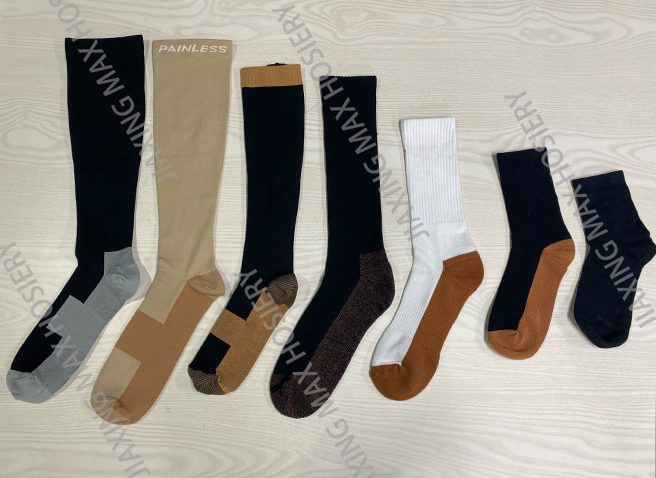Nowadays, more and more people are suffering from foot odor, especially in the summer when they wear socks all day long and tend to sweat, taking them off is very “smelly”, and people with strong sweat glands are prone to foot odor. The feet are wrapped in a confined shoe space for a long time, and the sweat produces bacteria that tend to multiply and break down keratin, coupled with urea and lactic acid in sweat, it will give off a bad smell, so the culprit of foot odor is the proliferation of bacteria. To solve the problem of smelly feet, it is fundamentally important to solve the problem of sterilization and bacterial inhibition. So can we add antibacterial yarn to our socks for a bacteriostatic effect? The answer is yes.
How can socks be antibacterial? There are two main ways to add antimicrobial agents to socks on the market, one is to use antibacterial yarn, the other is to use antibacterial auxiliaries.
Either way, raw materials with antibacterial ingredients are injected into yarns or auxiliaries to inhibit the growth of microorganisms on socks, thereby reducing the odor caused by such microorganisms.
Now, most antimicrobial agents can inhibit three types of fungi, such as Escherichia coli, Staphylococcus aureus, and Candida albicans, and the inhibition rate can reach more than 90%.
Material for anti-bacterial effect
Antibacterial socks can be made by adding antibacterial fibers such as silver, zinc, or copper fibers to the socks, or by post-treating the yarn, for example by adding antibacterial liquids. In terms of effectiveness, however, the direct addition of antibacterial yarn is more effective than antibacterial liquid, as the antibacterial properties of the liquid will diminish after several times of washing.
In addition, some yarns contain certain antibacterial properties themselves, such as bamboo fiber and COOLMAX. If additional silver fibers, copper fibers etc. are added to these yarns, they will have an even better antibacterial effect.
As sweat is usually found on the bottom of the foot, these yarns are usually added to the heel and toe of the sock, forming a coating that inhibits the growth of bacteria. Some customers will ask to be added to the upper leg part, but this is actually a way to increase the cost and it doesn’t make much sense.
Antibacterial testing
Chen Jian, the senior engineer of SGS General Standard Technical Service (Shanghai) Co., Ltd said, “Antibacterial socks are processed through antibacterial processing. After antibacterial processing, socks have the property of inhibiting the growth and reproduction of microorganisms, thus reducing the odor caused by microorganisms on socks. AAA grade is according to the testing standard of socks FZ/T73023-2006” Antibacterial knitwear “, in which the antibacterial properties are divided into three grades.
The highest grade is AAA, which tests the antibacterial properties of Staphylococcus aureus, Escherichia coli, and Candida albicans in socks after 50 times of washing.
Therefore, when testing antimicrobial socks, the conventional three strains areas are mentioned above. For the definition of different bacteria, we can refer to Wikipedia.
Below is a testing example of our socks, both silver and copper socks.

Antibacterial socks styles
In fact, there is no specific style of antibacterial socks, common we may see copper ion socks, silver ion socks as shown below. All socks can be added silver fiber or copper fiber and so on, so the style of antibacterial socks is more varied.
In addition, the color of antibacterial fiber can also be customized, usually, customers will dye these yarns to silver or copper color, so that consumers feel visual that these are silver ions or copper ions, but in fact these colors can be customized.
At the same time, we suggest that antibacterial ingredients can be added to socks for specific groups of people.
Such as pressure socks, diabetes socks, maternity socks and so on, because these people exercise a lot, or the feet have a certain degree of pathology, it is easier to breed bacteria.

Advise on socks purchasing
Consumers should pay attention to the following aspects when buying and using socks. First of all, when buying socks, we should look at its function, in addition to the routine implementation of standards and ingredients, but also pay attention to antibacterial properties, antibacterial grades, and antibacterial processing parts, etc.. Even if we choose products such as antibacterial socks, we should also pay attention to personal hygiene and change frequently, you can’t think that if you use antibacterial socks, then that they have the idea of treating diseases and preventing diseases.
It is recommended to buy back for a washing before wearing, the performance of antibacterial socks will gradually decline with the extension of time or the increase of washing times, we also suggest consumers to replace them in time.
The following are some regular videos and reports of antibacterial socks in our factory. If you have any inquiries, please feel free to contact us–Jiaxing Max Hosiery.

Follow us here:
